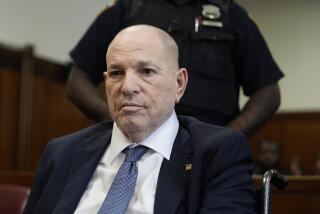Pains Prompt Urgent Heart Care for Cheney
- Share via
WASHINGTON — Vice President Dick Cheney, who has had four heart attacks, underwent a procedure Monday to widen a coronary artery after experiencing repeated episodes of chest pains since Saturday.
A cardiologist who treated Cheney on Monday at George Washington University Medical Center said he had seen no evidence “as of now” that the vice president, 60, had suffered a fifth attack.
President Bush said the hospitalization was a “precautionary measure.” Cheney had told Bush earlier in the day that he was not feeling well and would seek medical help.
Dr. Jonathan Reiner, director of the hospital’s cardiac catheterization laboratory, described the hourlong procedure as urgent, but not an emergency. He said that the vice president has “chronic coronary heart disease” and that in the future there was a 40% likelihood he would suffer arterial narrowing similar to that discovered Monday.
However, he said, “there is a very high likelihood he can finish out his term in his fully vigorous capacity.”
Cheney’s medical condition has hovered over his political career for more than two decades, but never as much as now. As vice president, he has been perhaps more involved in the daily work of his administration than any predecessor, playing a more crucial role even as he has sought to control his diet, get exercise, and follow healthful work habits.
He has become a regular fixture on Capitol Hill, working intensely on national security issues, and has become a spokesman for the administration’s congressional agenda in frequent satellite television interviews around the country and on the Sunday talk-show circuit.
Cheney arrived at the hospital seven blocks from the White House about 3:30 p.m. EST and was taken immediately to the laboratory.
There, doctors examined his coronary arteries, using a catheter inserted through a blood vessel in the groin. They discovered a narrowing of a mesh tube, approximately half-an-inch long and barely one-tenth of an inch in diameter, that they had inserted in an artery in November. The device, known as a stent, was then widened, using the balloon, to increase blood flow from the heart to other parts of the body.
“It’s like a garden hose that starts to fill with sediment,” Reiner said of the shrunken artery, which doctors had discovered in November was 90% blocked.
Cheney had his first heart attack at age 37.
Cheney was sedated and dozed on and off during the procedure, Reiner said. The doctor said the vice president “should be fully alert” this morning.
The vice president’s office said he “checked himself into George Washington hospital for a repeat cardiac catheterization after experiencing two brief, mild episodes of chest discomfort. This is a nonemergency precautionary procedure.”
Doctors later said Cheney first experienced the pain Saturday as he wrapped up an exercise routine. They said it occurred again Sunday and twice Monday, first in the morning and then in midafternoon.
The statement issued by Mary Matalin, the vice president’s counselor, said an electrocardiogram performed at the White House on Monday afternoon was unchanged from the results of the same test conducted last Thursday. The test measures the electric pulses that trigger heart contractions.
The test Thursday was conducted as part of what Reiner presented as a routine follow-up to the treatment Cheney received after his heart attack Nov. 22.
At that time, Bush, spokesmen for the Bush-Cheney campaign and medical personnel said Cheney had not suffered a heart attack. That more optimistic assessment was eventually abandoned after further diagnosis.
White House press secretary Ari Fleischer said Monday that Bush called Cheney to wish him well.
“During their five-minute phone call, the vice president told the president that he was feeling fine and looked forward to returning to work,” Fleischer said. Reiner said Cheney would remain hospitalized at least until this morning, and could return to work later in the week.
Cheney’s health has been a constant factor in his public appearances: At political lunches and dinners, his diet is scrutinized. In interviews, he is routinely asked how he is feeling.
“According to the doctors, I’m stronger and healthier than I was six months ago, because we’ve gone in and done that procedure,” Cheney said in December, on “Meet the Press,” after the stent was inserted. “If I had any doubts about that, or if they expressed any doubts or reservations about my capacity to do the job, I would not do it,” he said, adding he would “absolutely” step aside in that case.
If the vice presidency becomes vacant, the president picks a successor, who must be confirmed by Congress.
As recently as Sunday, Cheney was asked, on CNN, about his health.
“I feel great,” he said. “I am well behaved. They’ve taken control of my food supply. So I’m trying to do all those things you need do to be a responsible individual with a history of coronary artery disease and somebody who’s 60 years old. So far, so good.”
He has appeared to have lost weight, but his office has refused to say how much. In November, he was said to have weighed 210, about 35 pounds above the weight considered ideal for a man his age and height, 5-foot-10.
Reiner said that on Thursday he had reviewed Cheney’s exercise routine, about 30 minutes four or five times a week.
“He uses two pieces of exercise equipment, gets his heart rate up, gets a good bead of sweat going,” the doctor said. “And he’s been on a rather, to say it mildly, rigorous, rigorous diet.”
In addition to the procedures recently performed on Cheney, he could be a candidate for bypass surgery. “He’s already had one bypass, but people can have another,” said Dr. Hugh Trout, a Maryland vascular surgeon. Cheney underwent a quadruple bypass operation in 1988.
“You can go for a long time having these attacks, and if you can . . . keep the blood supply to [the heart muscle] you can go a long time having not a great heart,” Trout said. “Four heart attacks and ongoing angina is not a good sign. On the other hand, it’s not necessarily a death warrant in the next year, or next four years.”
“He could have angina to a small portion of his heart, and have the pain, and not be in threat of losing any large [heart] muscle mass,” he added. “But in somebody with three or four heart attacks, you don’t want to lose any more muscle mass than you have to. The goal here is essentially to preserve as much functioning muscle as possible . . . by maximizing blood flow to the muscle of the heart that is not getting enough.”
*
Times staff writers Marlene Cimons and Kathleen Howe contributed to this story.
More to Read
Get the L.A. Times Politics newsletter
Deeply reported insights into legislation, politics and policy from Sacramento, Washington and beyond. In your inbox twice per week.
You may occasionally receive promotional content from the Los Angeles Times.










